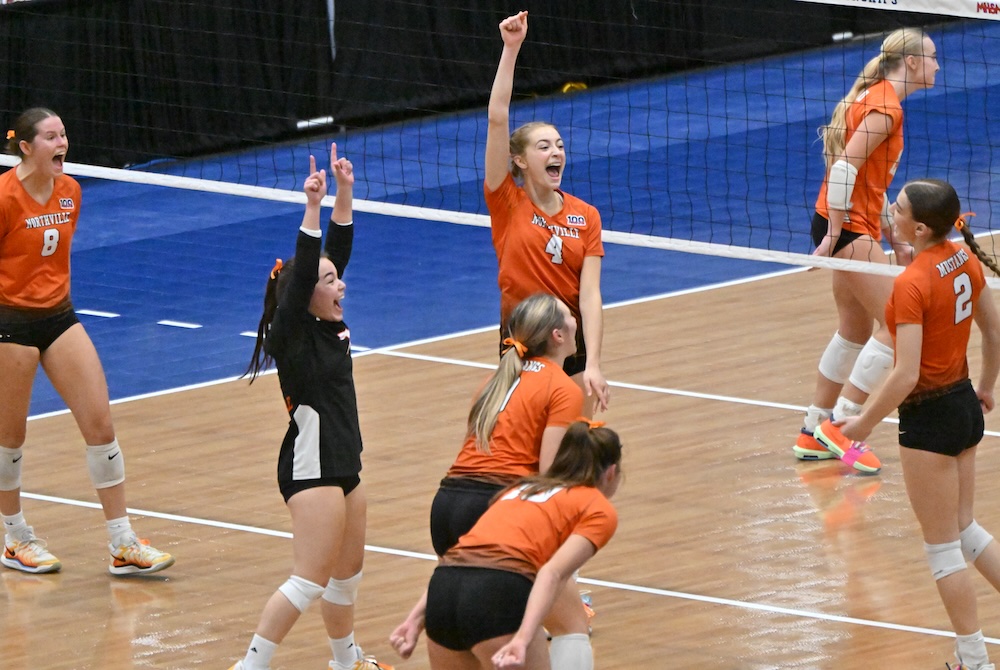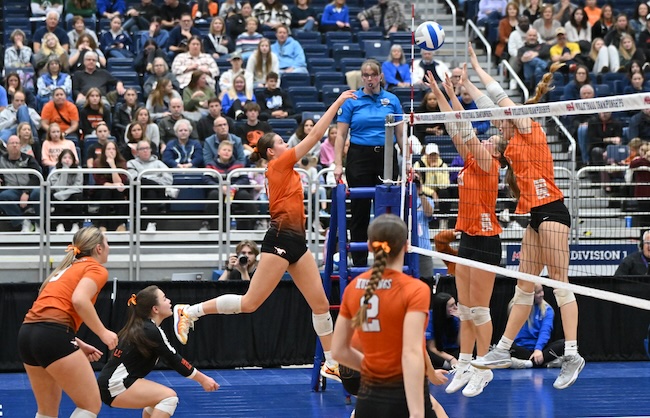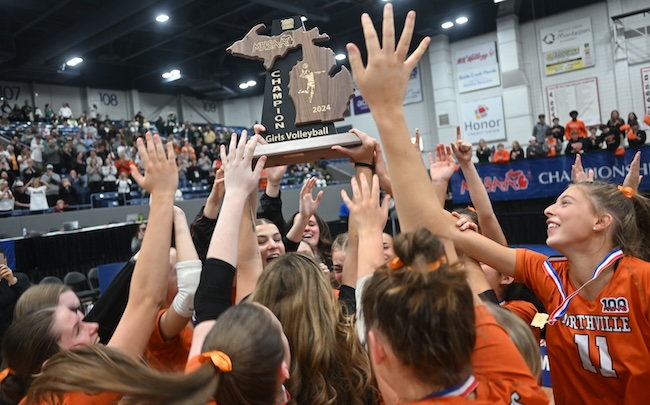
Casting Lines for Future Tournaments
August 12, 2016
By Jack Roberts
MHSAA Executive Director
The MHSAA is best known to the public for the tournaments it conducts to conclude the fall, winter and spring seasons each school year.
These tournaments, the first and largest program of the MHSAA, have survived the Vietnam War, the Korean conflict and two World Wars. They have survived the technology bubble, the housing collapse, the energy crisis and the Great Depression.
MHSAA tournaments existed at the dawn of aviation and at the time of our nation’s lunar landing. Popes, presidents and governors have changed and changed again and again, and MHSAA tournaments roll on year after year.
But the sense of tradition and permanence and inevitability of MHSAA tournaments doesn’t dissuade us from asking questions about our tournaments, even some of the most basic questions. Here are two.
Question #1
I have long been and will always be an advocate for a Ryder Cup format for the MHSAA Golf Finals, and a team tennis approach to the MHSAA Tennis Finals; but 90 years of tradition is hard to overcome. Might this be a more exciting format? Could it be co-ed? Could it reverse the decline in boys tennis participation, and increase girls golf participation? Wouldn’t it be fun to try?
Periodically, the International Olympic Committee requires each of the designated Olympic sports to defend its status, to state its case why the sport should remain a part of the Olympic program. Then, after a series or votes that retain one sport at a time, the IOC drops the sport that makes the weakest case. It does so to make room for one of the previously unlisted sports that makes the best case for inclusion.
This would appear to keep the existing Olympic sports on their toes, and to keep the Olympic movement fresh and reflective of modern trends in sports.
While I would not enjoy the controversy, I can see the potential for some positive results if the MHSAA were to invoke the same policy for determining the 14 tournaments it will provide for girls and the 14 for boys.
This might cause us to consider more deeply what a high school sport should look like, or at least what an MHSAA tournament sport should stand for.
On the one hand, we might be inclined to drop tournaments for those sports that involve mostly non-faculty coaches and non-school venues, or require cooperative programs to generate enough participants to support a team, or resort almost entirely to non-school funding, or cater to individuals more than teams.
Or perhaps this process would cause policymakers to forget traditional thinking and ask: “In this day and age, should we shake off traditional notions of sport and consider more where modern kids are coming from?” That might mean fewer team sports and more individual sports, more “extreme” sports like snowboarding and skateboarding, and more lifetime sports, meaning not just golf and tennis and running sports, but also fishing and even shooting sports.
Currently, MHSAA policy states that the MHSAA will consider sponsorship of a tournament series for any sport which 64 member schools conduct on an interscholastic basis as a result of action by the governing boards of those schools.
Should the only question be how many schools sponsor a sport, or must an activity also have certain qualities and/or avoid certain “defects?” What should an MHSAA tournament sport look like and stand for?
Question #2
Bristling from criticism that his association is a money-grabbing exploiter of children, my counterpart in another state said, “If we were running our programs just to make money, we would do very many things very differently.” I knew exactly what he meant.
Because we care about the health and welfare of students, because we mean what we say that the athletic program needs to maximize the ways it enhances the school experience while minimizing academic conflicts, and because we try to model our claim that no sport is a minor sport when it comes to its potential to teach young people life lessons, we operate our programs in ways that make promoters, marketers and business entrepreneurs laugh, cry or cringe.
If money were the only object, we would seed and select sites to assure the teams that attracted the most spectators had the best chance to advance in our tournaments, regardless of the travel for any team or its fan base. If money were the only object, we would never schedule two tournaments to overlap and compete for public attention, much less tolerate three or four overlapping events. If money were the only object, we would allow signage like NASCAR events and promotions like minor league baseball games.
Those approaches to event sponsorship may not be all wrong; they’re just not all right for us. And we will live with the consequences of our belief system.
During a typical school year, more than 20 percent of the MHSAA’s 2,097 District, Regional and Final tournaments lose money. Not a single site in golf, skiing or tennis makes a single penny. In no sport did every District, Regional and Final site have revenue in excess of direct expenses.
In fact, in only three sports – boys and girls basketball and football – is revenue so much greater than direct expenses overall that it helps to pay for all the other tournaments in which the MHSAA invests.
That’s right: invests. When we present our budget to our board, we talk about the MHSAA’s investment in providing tournament opportunities in all those sports and all those places that cannot sustain the cost of those events on their own. How much is this investment worth to students, schools and society?
These two are core questions that require our focus far in advance of talk about scheduling, site selection, seeding and the myriad matters that too often hijack our time and attention.

Northville Finishes 3rd-Straight Trip to Kellogg as 1st-Time Finals Champion
By
Paul Costanzo
Special for MHSAA.com
November 23, 2024
BATTLE CREEK – As the Northville volleyball team knows all too well, only one team in each division can leave Kellogg Arena happy each year.
For the first time Saturday, the Mustangs were that team in Division 1.
After finishing as runner-up in 2022 and losing in the Semifinals in 2023, Northville got over the hump this year, defeating Rockford 26-24, 25-16, 25-27, 25-22 to claim its first Finals title on the volleyball court.
“Every time I’ve walked out of this place, I’ve been sad for the last two years,” Northville senior Molly Reck said. “Being able to leave happy is just an indescribable feeling. I can’t even put it into words.”
Reck and her twin sister Mallory, along with senior setter Ella Craggs and junior libero Giselle Burlingame, were part of each team that made it to the final weekend over the past three years. On Saturday, they were winning not only for themselves and their teammates, but everyone who had come with them before.
 “Their sister, Abby Reck, when we were in the Finals (in 2022) came into the locker room and said, ‘You’ll be back, this will help you,’” Northville coach Sarah Lindstrom said. “(Former players) Greta McKee, Ashlee Gnau, Avry Nelson, Ava Thomas, these players that were here for the last four years that bought into what we were bringing to Northville. Northville was good at volleyball before, but these kids trusted us and our coaching staff, and this wasn’t just for the people here. We kept saying during that match, this is for all of your teammates in the past that have built something, brick by brick they put together what we think might be a dynasty. We’re just so grateful for everybody that’s been a part of this.”
“Their sister, Abby Reck, when we were in the Finals (in 2022) came into the locker room and said, ‘You’ll be back, this will help you,’” Northville coach Sarah Lindstrom said. “(Former players) Greta McKee, Ashlee Gnau, Avry Nelson, Ava Thomas, these players that were here for the last four years that bought into what we were bringing to Northville. Northville was good at volleyball before, but these kids trusted us and our coaching staff, and this wasn’t just for the people here. We kept saying during that match, this is for all of your teammates in the past that have built something, brick by brick they put together what we think might be a dynasty. We’re just so grateful for everybody that’s been a part of this.”
The Reck twins and Craggs led the Northville attack Saturday, with Molly (26) and Mallory (20) combining for 46 kills and Craggs finishing with 49 assists. Mallory Reck added 15 digs, while Molly Reck had 10.
But they were far from alone. Burlingame had 18 digs, while junior Kaylyn Tuck had seven kills and four blocks and senior Brooke Feller had six blocks.
“We put a lot of work into – I kept telling them, ‘The three of you (Reck, Reck and Craggs) can’t win a state championship,’” Lindstrom said. “‘We’ve seen that before. You need other people around you.’ And we work on our cohesiveness all the time and building up those other kids.”
 Northville (41-2) nearly swept its way to the title, as it had a match point in the third set. But Rockford held on, thanks to a pair of kills from Olivia Hosford to take a 25-24 lead, and eventually won the set to force a fourth.
Northville (41-2) nearly swept its way to the title, as it had a match point in the third set. But Rockford held on, thanks to a pair of kills from Olivia Hosford to take a 25-24 lead, and eventually won the set to force a fourth.
“I just have so much confidence in every single one of my teammates,” Rockford senior Layla Visser said. “I know what we can do. We can put the ball away, and we can make the right play no matter how many points we’re down.”
That confidence in each other carried over to the fourth set for the Rams. While it was mostly back and forth, Rockford was able to build a 20-16 lead before Northville closed on a 9-2 run to win the title. Mallory Reck served out the final four points, with a pair of aces to close the victory.
“In my head I was kind of just thinking, ‘As much as I don’t want to serve this ball, I know the feeling of being on the other side, and they don’t want to pass this ball just as much,’” Mallory Reck said. “So, that kind of just calmed me down and I was thinking, ‘Serve to get an ace.’ That’s what we’ve worked on all year; we’ve focused really hard on serving. I just took a deep breath and just served it.”
Hosford led the Rockford attack with 22 kills, adding 11 digs. Sophomore Mallory Wandel had 16 kills and 19 digs, while Visser had 10 kills. Isabella Delacher had 25 assists, Ashley Williams had 22 assists, and Eleanor Goad had 12 digs for the Rams (41-10).
“Proud of our girls. They battled against a very good Northville team,” Rockford coach Kelly Delacher said. “It felt like we might have been down and out after the second set and midway through the third set, and they did a great job of battling back to force that fourth set. Overall, proud of my players and proud of our seniors and the way they led us out there.”
PHOTOS (Top) Northville’s side of the court celebrates Saturday, including Brooke Feller (4). (Middle) The Mustangs’ Molly Reck (8) sends a spike into an awaiting Rockford block. (Below) Northville players raise their championship trophy. (Photos by Hockey Weekly Action Photos.)

